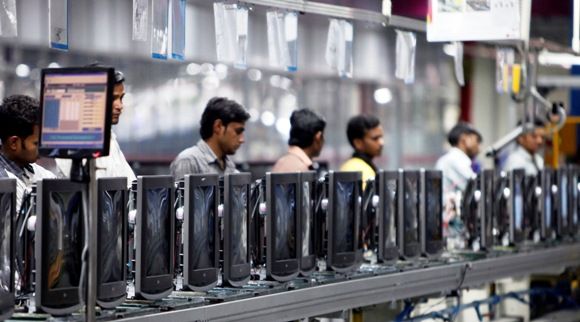 | « Back to article | Print this article |
 The sharp rise was also due to a statistical illusion -- low industrial numbers in November 2015, and sharp reversal of a 12-month declining trend in capital goods.
The sharp rise was also due to a statistical illusion -- low industrial numbers in November 2015, and sharp reversal of a 12-month declining trend in capital goods.
Industrial activity rose to a 13-month high of 5.7% in November, belying expectations of an adverse impact from demonetisation. It had contracted 1.8% in October, revealed the Index of Industrial Production data released on Thursday.
However, the sharp rise was also due to a statistical illusion -- low industrial numbers in November 2015, called the base effect (the IIP fell 3.4% last November), and sharp reversal of a 12-month declining trend in capital goods, helped by highly volatile cable and insulated rubber. If capital goods are taken out, IIP rose 4.7% in November, against 2.1% in the previous month.
If the trend prevails in the coming months, Advance Estimates of 7.1% gross domestic product growth for 2016-17 would not be revised drastically, beating popular perception. However, economists cautioned against too much interpretation of the data as December might show low industrial production.
Industry was projected to grow at 5.2% in the GDP data for 2016-17, against 7.4% in the previous financial year. GDP data is in terms of rupees, while IIP is an index.
The sharp rise in IIP in November could also be gauged from the fact that the index rose just 0.4% in the first eight months of the current financial year (April-October), against 3.8% in the corresponding period of the previous year.
That the index in FY17 November had a low base effect was evident as IIP was at the bottom in 2016-17 so far, at 166.3 points in November. In terms of growth, IIP fell 3.4% in November 2015-16.
Sunil Kumar Sinha, principal economist, India Ratings & Research, said, “IIP grew mainly due to the base effect... On the whole, there is nothing to cheer about the November IIP growth as the cumulative growth for April-November this fiscal is lower than that in the corresponding period a year ago.”
“In most years, we caution against analysing data for October and November individually, as shifts in the festive calendar often distort factory dispatches. In 2016, the distortions would extend to December as well, with an early Diwali dampening output in October, fewer holidays obscuring the impact of note ban in November, and an expected adjustment in inventories likely to affect output growth in December,” ICRA principal economist Aditi Nayar said.
The manufacturing sector, which constitutes 75% of the index, grew 5.5% in November, aided by capital goods and passenger cars, against a decline of 2.4% in October. Manufacturing in GDP data was projected to grow at 7.4% in 2016-17, against 9.3%, a year ago.
Electricity generation was up almost nine%, against 1% a year ago. Mining output grew 4%, against a decrease of 0.7% in the same month a year ago.
Capital goods saw a spurt of 15%, compared to a decline of 27% in October. The sector is highly volatile in the IIP.
Production of tractors was up 95%, while passenger car production grew 29.5% in November, contributing to a 0.8-per cent rise in IIP. In the automobiles segment, motor vehicles, trailers & semi-trailers rose 23.2% in November.
Radio, TV and communication equipment grew 30%, electrical machinery and apparatus was up 23% and machinery and equipment by 13%.
The consumer durables segment surged almost 10% in November, against a 0.6%, a year ago.